This article was co-authored by Francisco Gomez and by wikiHow staff writer, Savannah Vold. Francisco Gomez is the Head Coach at the FIT Potato Gym, a training gym established in 2001 in the San Francisco Bay Area. Francisco is a former competitive runner who helps endurance athletes train for major marathons like the Boston Marathon. Francisco specializes in Injury Rehab, Flexibility, Marathon Training, and Senior Fitness. He has a B.S. in Nutrition and Exercise Physiology & Running.
There are 18 references cited in this article, which can be found at the bottom of the page.
This article has been viewed 288,146 times.
So ice baths reduce anxiety, boost mood, and ease muscle aches? Sign me up! While stepping into icy cold water doesn't seem very appealing, ice bath offer so many benefits. They can help relieve soreness, reduce inflammation, boost your energy, and they're even thought to aid in the battle against depression and other mental illnesses.[1] If you’ve been curious about how to take an ice bath at home, you’ve come to the right place. In this article, we’ll teach you all about the 3 best DIY ice bath methods and when to use them to help achieve a variety of health benefits.
Things You Should Know
- Fill your tub up halfway with cold water. Then, add three 5 lb (2.3 kg) bags of ice to chill the water to around 55 to 68 °F (13 to 20 °C).
- Slowly submerge your body into the ice bath and take deep breaths to calm down and help lower your heart rate.
- Don’t stay in an ice bath for longer than 5-10 minutes.
- Warm yourself up after your bath by putting on warm clothing, covering yourself with a blanket, and/or sipping a hot decaffeinated beverage.
Steps
Soaking After a Workout
-
1Use this method to reduce muscle soreness and inflammation. Who knew getting chilly could have so many benefits? Research suggests that ice baths may result in the following benefits:[2]
- Reduction of inflammation and muscle soreness: Cold exposure constricts blood flow to the areas of your body being exposed to the icy water, numbing pain receptors and reducing inflammation.[3]
- Muscle recovery: Upon getting out of the ice bath, your circulation will increase as your body warms up, resulting in the movement of fluids and overall relaxation of the muscles.[4]
-
2Take your ice bath within 30 minutes after exercising. Ice baths are only helpful in reducing aches and pains if you take them right after a workout. Ice baths help your body recover from a workout faster and reduce swelling in your muscles as they remove waste products from your body, like lactic acid, which in excess, can cause muscle stiffness. Plan your bath immediately after your workout of choice to get the most out of your ice bath.[5]
- Don’t take an ice bath before a workout or competition, as it can cause muscle stiffness and may decrease your performance ability.
- Additionally, your body may feel less tired since lactic acid may cause fatigue.[6]
Advertisement -
3Fill your tub halfway with cold water. Turn on the cold water and wait for the water level to rise about halfway up the side of the tub. Then, shut off the water faucet. Since your body and the addition of ice will increase the water volume, don’t fill up the tub more than halfway to prevent it from overflowing—nobody likes a slippery bathroom floor! [7]
- If you feel like your water level is too low, you can always turn on the cold water to raise the water after you’ve added your ice and gotten in.
- If you don’t have a bathtub, use a kiddie pool or large plastic tub for your ice bath and fill it with your garden hose.
- You can also use a portable ice bath, filling it up with the same amount of water and ice as you would a tub.
-
4Add three 5 lb (2.3 kg) bags of ice to chill the water to 55 to 68 °F (13 to 20 °C). Use store-bought ice or ice from your freezer, depending on what’s most convenient. Pour the ice into your bath in small quantities to lower the temperature. Use a thermometer to check the water’s temperature and stop adding ice when it reaches about 55 to 68 °F (13 to 20 °C).[8]
- If you don't have a thermometer, you can estimate the temperature by plunging your elbow beneath the surface.
- If this is your first ice bath, add enough ice to lower your water temperature to around 60 to 70 °F (16 to 21 °C) to get your body used to managing cold temperatures.
- Slowly decrease the temperature of your ice bath by 1-2 degrees each time you take an ice bath until you get down to about 55 °F (13 °C). Never go any lower than 53 °F (12 °C).
-
5Shower off before your ice bath to prevent skin conditions. Workouts can get you grimy— sweat, dirt, and germs from gym equipment, flooring, or terrain can expose you to bacteria you wouldn’t want to bring into your ice bath and potentially spread in the water. While it’s rare, it’s possible that bacteria or grime on your skin can lead to a skin condition if you get in an ice bath dirty. Before your bath, take a short, lukewarm shower to soap up so that you’ll be clean when you get in the bath.[9]
- Washing off beforehand is especially important if you share an ice bath with fellow athletes. Sharing a bath without washing increases the risk of infection for everyone who uses it.
-
6Put on shorts and foot booties to protect sensitive areas. Cold water can damage sensitive skin, so wear protective clothing to cover your genitals and feet. Swimming trunks, shorts, or briefs can help keep your genital area warm, while wetsuit booties can help to keep your feet from freezing.[10]
- If you can't get booties, try wearing socks instead for a bit of extra coverage.
- If you are only soaking the lower half of your body, you might even wear a sweatshirt in the bath, so your upper body stays warm.
-
7Submerge your lower body under the ice water slowly. Start with your feet, then ease the rest of your lower body into the water. Getting into the cold water too quickly can shock your system and may make your heart race, so it’s best to give yourself time to adjust by taking your time getting in. Take slow, deep breaths to stay calm and help stabilize your heart rate.[11]
- Sitting on the side of the tub with just your feet in the water is okay if a full plunge is too uncomfortable.
- Take as much time as you need to adjust to the cold water—slow and steady wins the race.
-
8Dip your upper body into the ice bath if desired. When you feel adequately adjusted to the cold, sink lower in the water to immerse your arms, shoulders, and chest. Stay under the water only if you feel like you can tolerate it. If you start to feel too cold or shaky, lift your body out of the water immediately.[12]
- Always do what feels comfortable, and don’t push yourself. Cold water can shock your system, so take things slow.
- You may not want to soak your upper body if you’re only trying to soothe your lower extremities like leg and hip muscles. Do what feels best to you.
-
9Soak for 5-10 minutes to help you recover. Settle into the water and take deep breaths to help you relax. It may help to count your breaths, which can take your mind off the cold. Set a timer for 5-10 minutes and try to stay in your bath until the timer goes off.[13]
- If you can’t stand the cold, getting out of the bath early is okay! Don’t push your body past its limits.
- Lay a towel outside your tub on the ground so you don't slip when you get out of the water.[14]
Variation: After you become accustomed to taking ice baths, you may increase the length of your bath to up to 20 minutes. However, never soak in ice water for longer than 20 minutes, as it can damage your skin or cause health problems.
Using Ice Baths for Energy & Mental Health
-
1Use this method to improve your mood, productivity, and sleep. When exposed to cold temperatures, our body produces several naturally occurring chemicals, such as melatonin and adrenaline. Research suggests that ice baths could be highly beneficial, aiding in the following:[15]
- Mood and energy booster: A cold plunge might be just what you need to snap your brain into action. This polar plunge sends signals of adrenaline and endorphins to your brain, leaving you feeling more alert and in a better mood.[16]
- Improved sleep: When our body temperature lowers, we produce melatonin, the natural chemical that makes us tired. An ice bath before bed may lead to better, more restful sleep due to increased melatonin production.[17]
-
2Check with your doctor before using cold therapy to treat yourself. Ice baths may help you get a burst of energy or improve your mood. However, they aren’t appropriate for everyone, especially if you have an underlying health condition. Talk to your doctor about why you want to try cold therapy and learn if it’s right for you.[18]
- For instance, taking ice baths can be dangerous if you have a heart condition. Your doctor can help you determine if you have any risks that might make it harmful to take an ice bath.
-
3Fill your tub halfway with cold water. Don’t fill up your tub all the way because the ice and your body will raise the volume of the water. Turn on the faucet and wait for the water to rise halfway up the tub. Then, switch off the water faucet.[19]
- Portable ice baths are a convenient alternative to using a tub if you don’t have one at home—plus, you can even use it outside! Simply fill it with the same amount of water and ice as you would a tub.
-
4Add around 2 5 lb (2.3 kg) bags ice to lower the temperature to about 68 °F (20 °C). Use store-bought ice or ice from your freezer, whichever is most convenient for you. Drop a few handfuls of ice in the tub, then check the temperature with a thermometer. Continue to add ice in small amounts until the water reaches about 68 °F (20 °C).[20]
- Lower the tub temperature, so it’s colder if you like. However, don’t lower it below 55 °F (13 °C), which can harm your skin.[21]
-
5Relax in the tub for about 5 minutes and take slow, deep breaths. Sit back against the back of your tub and try to enjoy your soak. Breathe slowly in and out, drawing the air deep into your lungs. You might also count your breaths to help you relieve any tension in your body. Set a timer for 5 minutes and try to stay in the bath until it goes off.[22]
- Get out of the bath early if you feel uncomfortable or your heart is racing. Don’t push your body further than it’s ready to go.
-
6Take a 1-3 minute cold shower for an easier option. You can still get the benefits of cold therapy you want without soaking in a tub. Instead, stand under a cold shower for at least a minute. If you can bear it, stay under the water for 3 minutes.[23]
- For a daily energy boost, end your morning shower with a blast of cold water.
Tip: It’s okay to ease yourself into using cold water. Start with a warm shower and slowly decrease the temperature over 5 minutes. Then, finish your shower with a 1-3 minute blast of cold water.[24]
-
7Use cold therapy once or twice daily to improve your energy and mood. Take your cold bath or shower early in the morning to improve your mood for the day. If you like, take another bath or shower later in the day for maximum results. Continue using it as long as you feel like it’s helping you have more energy or cope with your anxiety or depression.[25]
- Ice baths are a positive stressor that will likely give you a burst of adrenaline. Since adrenaline gives you energy, a quick ice bath may help you feel more awake and improve productivity.
- Cold water constricts your blood vessels in your extremities to preserve heat, which forces your blood to your core and brain. This oxygen boost can improve your mental health.
- Cold therapy isn’t a substitute for working with a therapist or taking medication for anxiety or depression. Don’t stop any of your prescribed treatments unless your doctor says it’s okay.
Tip: Cold therapy works best if you do it consistently. Take a cold bath or shower daily to see if it helps you get the desired results.[26]
Warming Yourself up After an Ice Bath
-
1Towel off after your bath. Get out of the tub and immediately wrap a towel around yourself. Pat yourself down to remove all of the cold water from your skin.[27]
- For maximum coziness, use a warm towel straight out of the dryer to heat yourself back up.
-
2Put on sweats or warm yourself with a thick blanket. Once your skin is dry, pull on warm clothing to help raise your body temperature.[28] Wear sweats or something similar, like a thick bathrobe. You might also cover yourself with a blanket.
- If you’re shivering, continue to add more clothing to help you warm up faster.
-
3Increase your body temperature by sipping on a hot beverage. Hot coffee, tea, or broth will help you warm up faster. Brew your decaffeinated coffee or tea, or heat some broth. Then, take small sips of your beverage rather than gulps as not to shock your body with the temperature difference.[29]
- Stick to decaf to avoid stressing your heart further.
-
4Wait 2 hours before you take a warm bath or shower if possible. Taking a warm shower or bath too soon after an ice bath may reduce the effects of the cold therapy, no matter your goal. Unless you’re having trouble warming yourself back up, wait at least 2 hours before you take a warm bath or shower.[30]
- If you’re still freezing after wearing thick clothing and drinking a warm beverage, hopping in the shower is okay. The warm water should warm you up faster.
Community Q&A
-
QuestionWhy do you feel so could hours after taking an ice bath?
 wikiHow Staff EditorThis answer was written by one of our trained team of researchers who validated it for accuracy and comprehensiveness.
wikiHow Staff EditorThis answer was written by one of our trained team of researchers who validated it for accuracy and comprehensiveness.
Staff Answer wikiHow Staff EditorStaff AnswerIce baths significantly lower your core body temperature, making you feel cold for longer. Layer up with warm clothing and a blanket after an ice bath to get your body back to its normal temperature.
wikiHow Staff EditorStaff AnswerIce baths significantly lower your core body temperature, making you feel cold for longer. Layer up with warm clothing and a blanket after an ice bath to get your body back to its normal temperature. -
QuestionAfter a really intense stretching routine, would taking an ice bath be advisable?
 wikiHow Staff EditorThis answer was written by one of our trained team of researchers who validated it for accuracy and comprehensiveness.
wikiHow Staff EditorThis answer was written by one of our trained team of researchers who validated it for accuracy and comprehensiveness.
Staff Answer wikiHow Staff EditorStaff AnswerYes, an ice bath will help to reduce inflammation or any aches and pains associated with an intense stretching routine.
wikiHow Staff EditorStaff AnswerYes, an ice bath will help to reduce inflammation or any aches and pains associated with an intense stretching routine. -
QuestionIs it bad to take an ice bath regularly?
 wikiHow Staff EditorThis answer was written by one of our trained team of researchers who validated it for accuracy and comprehensiveness.
wikiHow Staff EditorThis answer was written by one of our trained team of researchers who validated it for accuracy and comprehensiveness.
Staff Answer wikiHow Staff EditorStaff AnswerNo, many people choose to take an ice bath once daily to help them wake up, reduce stress, and aid in muscle recovery.
wikiHow Staff EditorStaff AnswerNo, many people choose to take an ice bath once daily to help them wake up, reduce stress, and aid in muscle recovery.
Warnings
- Ice baths are unsuitable for people with heart disease, high blood pressure, diabetes, peripheral neuropathy, poor circulation, venous stasis, or cold agglutinin disease.[33]⧼thumbs_response⧽
- Do not take ice baths that are colder than 55 °F (13 °C), as you could expose yourself to the risk of hypothermia or muscle damage.[34]⧼thumbs_response⧽
- Do not stay in an ice bath longer than 20 minutes, as this can damage your muscles. If you start feeling too cold, uncomfortable, or in pain, get out of the bath.[35]⧼thumbs_response⧽
- Ice baths will not help you build muscle or improve your strength. In many cases, they can actually reduce gains. You should only use an ice bath if you need to reduce soreness.[36]⧼thumbs_response⧽
References
- ↑ https://www.psychologytoday.com/us/blog/inner-source/201407/cold-splash-hydrotherapy-depression-and-anxiety
- ↑ https://fortune.com/well/2022/06/11/do-ice-baths-have-health-benefits/
- ↑ https://www.urmc.rochester.edu/encyclopedia/content.aspx?contenttypeid=134&contentid=95
- ↑ https://wexnermedical.osu.edu/blog/ice-baths-muscle-growth
- ↑ https://www.ncbi.nlm.nih.gov/pmc/articles/PMC2938508/
- ↑ https://www.mensjournal.com/health-fitness/benefits-of-cold-therapy/
- ↑ https://health.clevelandclinic.org/can-ice-baths-ease-my-sore-muscles/
- ↑ https://health.clevelandclinic.org/can-ice-baths-ease-my-sore-muscles/
- ↑ https://www.quebec.ca/en/health/health-issues/a-z/health-problems-associated-with-bathing-waters
- ↑ https://www.mensjournal.com/health-fitness/benefits-of-cold-therapy/
- ↑ Francisco Gomez. Athletic Trainer. Expert Interview. 25 October 2019.
- ↑ https://www.mensjournal.com/health-fitness/benefits-of-cold-therapy/
- ↑ Francisco Gomez. Athletic Trainer. Expert Interview. 25 October 2019.
- ↑ Francisco Gomez. Athletic Trainer. Expert Interview. 25 October 2019.
- ↑ https://fortune.com/well/2022/06/11/do-ice-baths-have-health-benefits/
- ↑ https://pubmed.ncbi.nlm.nih.gov/30131418/
- ↑ https://pubmed.ncbi.nlm.nih.gov/33870188/
- ↑ https://www.psychologytoday.com/us/blog/inner-source/201407/cold-splash-hydrotherapy-depression-and-anxiety
- ↑ https://www.ncbi.nlm.nih.gov/pmc/articles/PMC5025014/
- ↑ https://www.psychologytoday.com/us/blog/inner-source/201407/cold-splash-hydrotherapy-depression-and-anxiety
- ↑ http://onlinelibrary.wiley.com/doi/10.1113/JP270570/full
- ↑ https://www.psychologytoday.com/us/blog/inner-source/201407/cold-splash-hydrotherapy-depression-and-anxiety
- ↑ https://www.ncbi.nlm.nih.gov/pmc/articles/PMC5025014/
- ↑ https://www.ncbi.nlm.nih.gov/pubmed/17993252
- ↑ https://pubmed.ncbi.nlm.nih.gov/17993252/
- ↑ https://www.ncbi.nlm.nih.gov/pmc/articles/PMC5025014/
- ↑ https://physoc.onlinelibrary.wiley.com/doi/full/10.1113/JP270570
- ↑ https://alamocityuc.com/6-simple-tips-for-using-an-ice-bath-for-injury-recovery/
- ↑ https://alamocityuc.com/6-simple-tips-for-using-an-ice-bath-for-injury-recovery/
- ↑ http://onlinelibrary.wiley.com/doi/10.1113/JP270570/full
- ↑ http://onlinelibrary.wiley.com/doi/10.1113/JP270570/full
- ↑ http://onlinelibrary.wiley.com/doi/10.1113/JP270570/full
- ↑ https://health.clevelandclinic.org/can-ice-baths-ease-my-sore-muscles/
- ↑ http://onlinelibrary.wiley.com/doi/10.1113/JP270570/full
- ↑ http://onlinelibrary.wiley.com/doi/10.1113/JP270570/full
- ↑ https://www.stack.com/a/ice-baths
About This Article
To start an ice bath, fill your bathtub halfway with cold water and add half of a bag of ice. Make sure to dip a thermometer into the water and add warm water if the temperature goes below 55 degrees Fahrenheit. Otherwise, you risk damaging your skin. Before hopping in, put on shorts and foot booties to protect your sensitive areas from getting too cold. When you first start taking ice baths, only submerge the lower half of your body, because you might shock your body by overdoing it. After 6 to 8 minutes of relaxing in the tub, get out, dry off, and put on a sweatshirt to warm yourself up. Avoid spending more than 20 minutes in an ice bath, as it could be dangerous to your health. For more help from our Fitness co-author, like how to fit ice baths into your workout routine, read on!

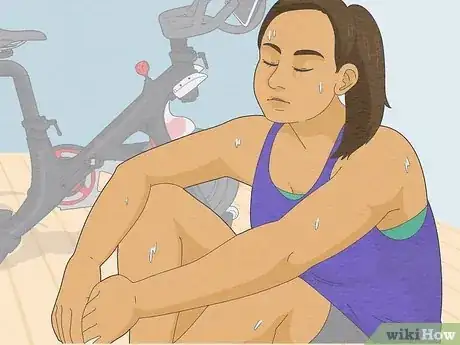
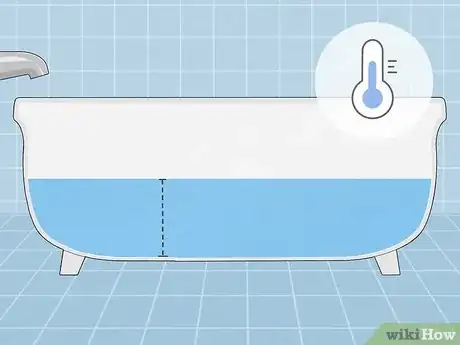
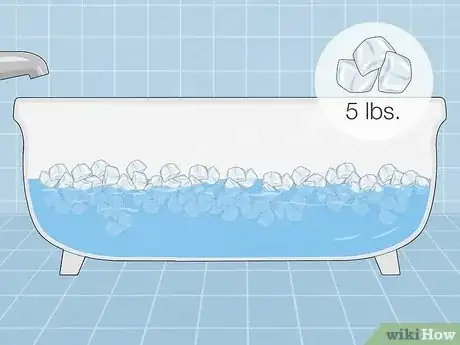

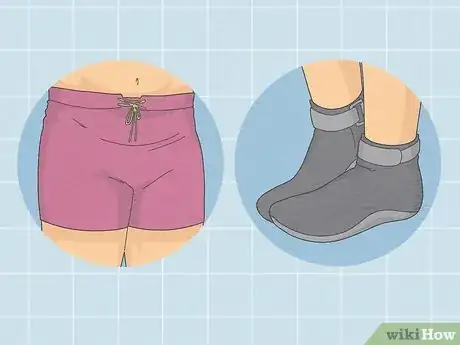
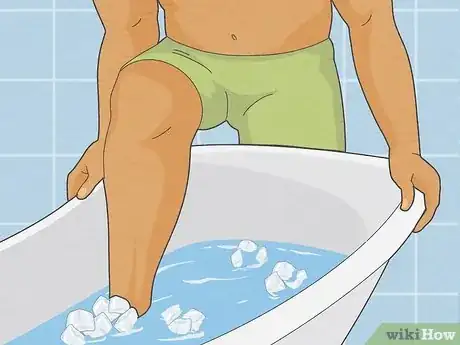

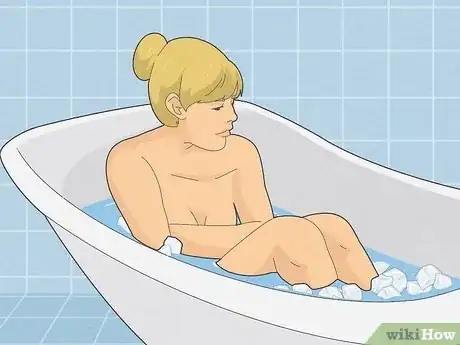



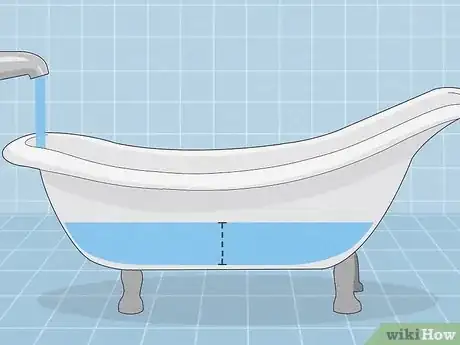
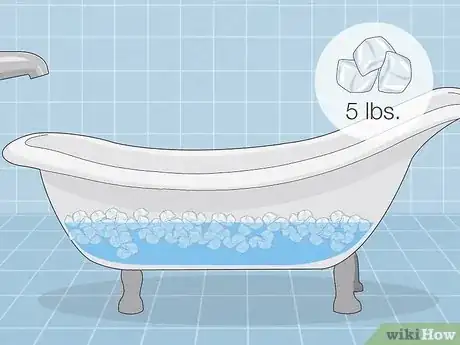

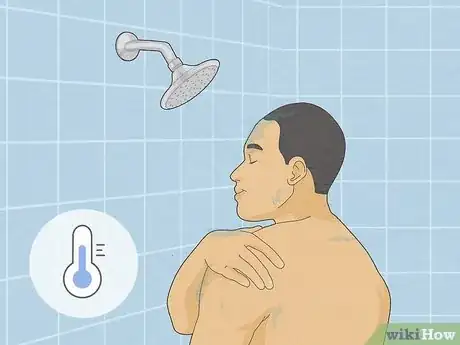
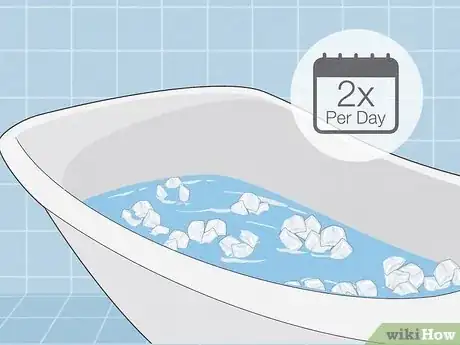
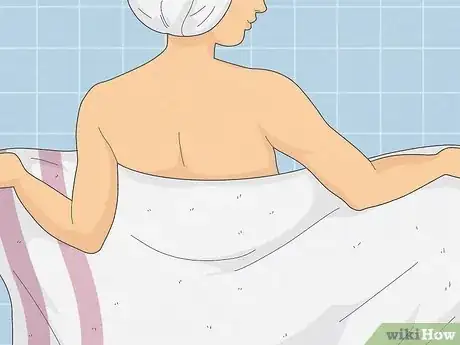


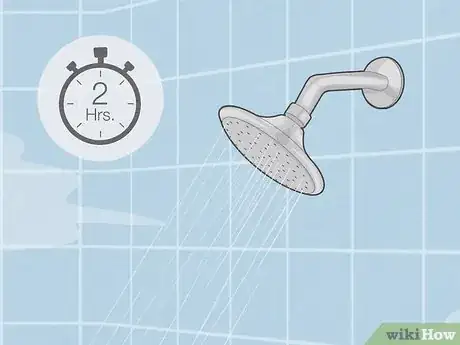



























































Medical Disclaimer
The content of this article is not intended to be a substitute for professional medical advice, examination, diagnosis, or treatment. You should always contact your doctor or other qualified healthcare professional before starting, changing, or stopping any kind of health treatment.
Read More...